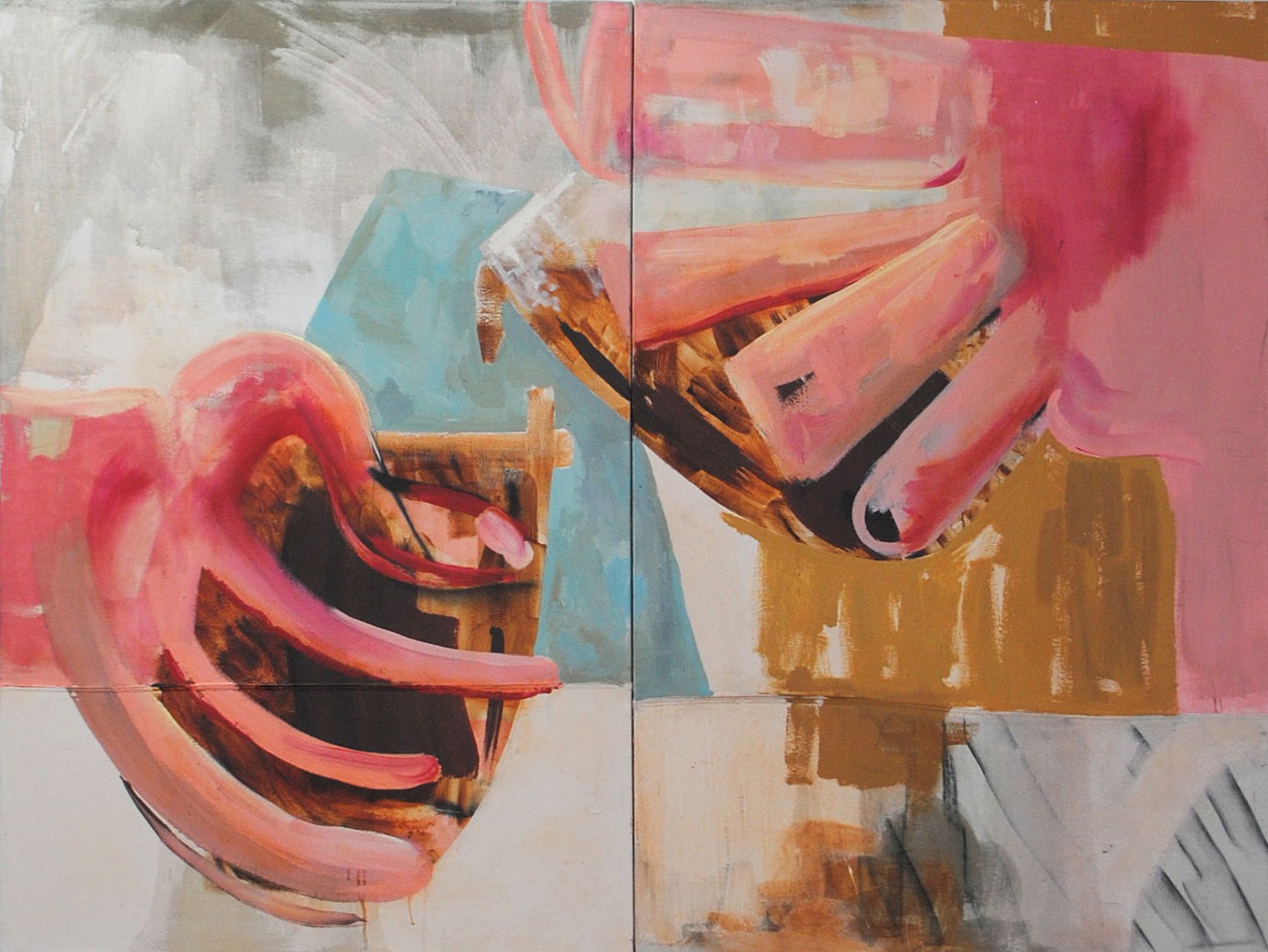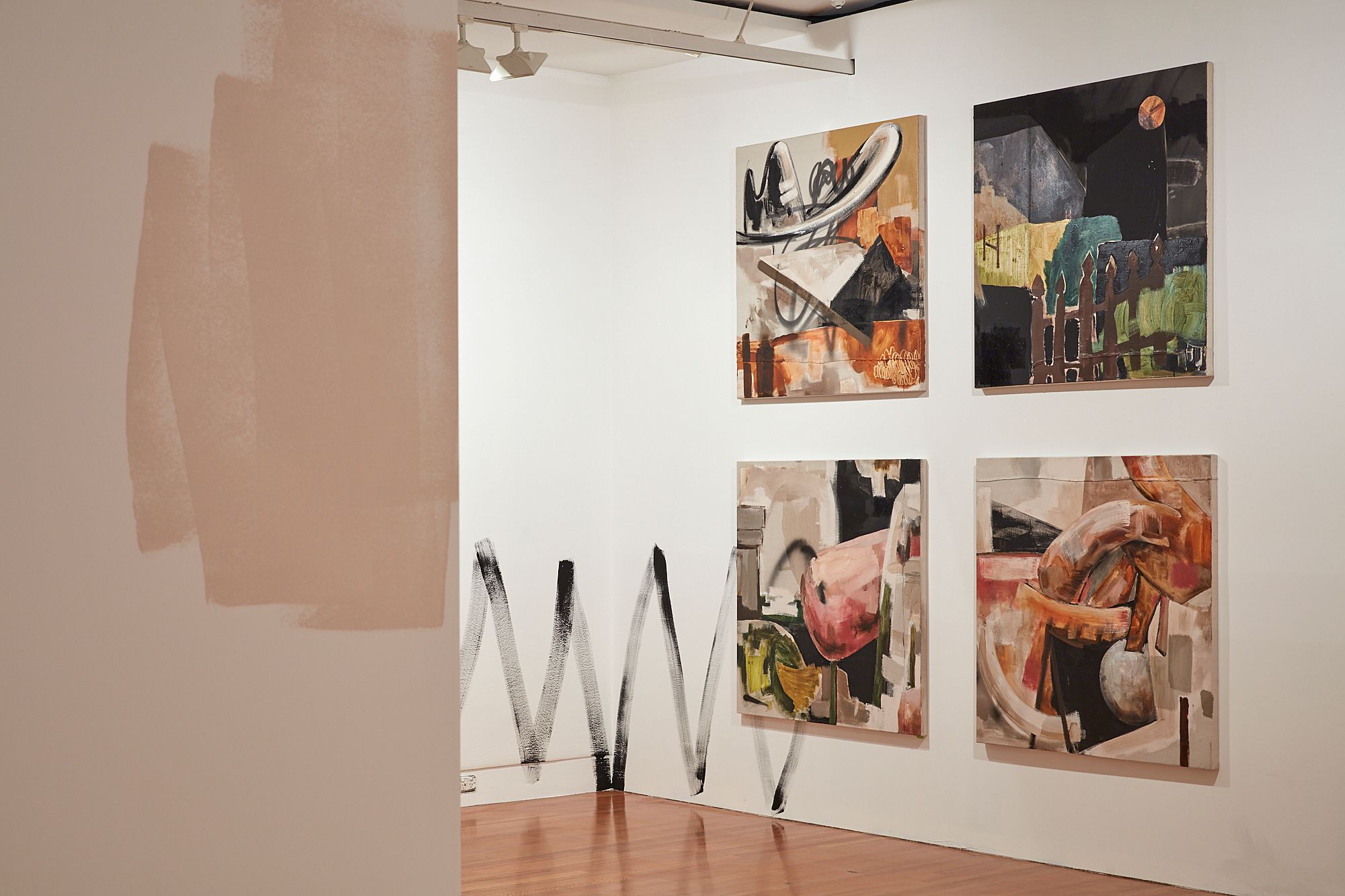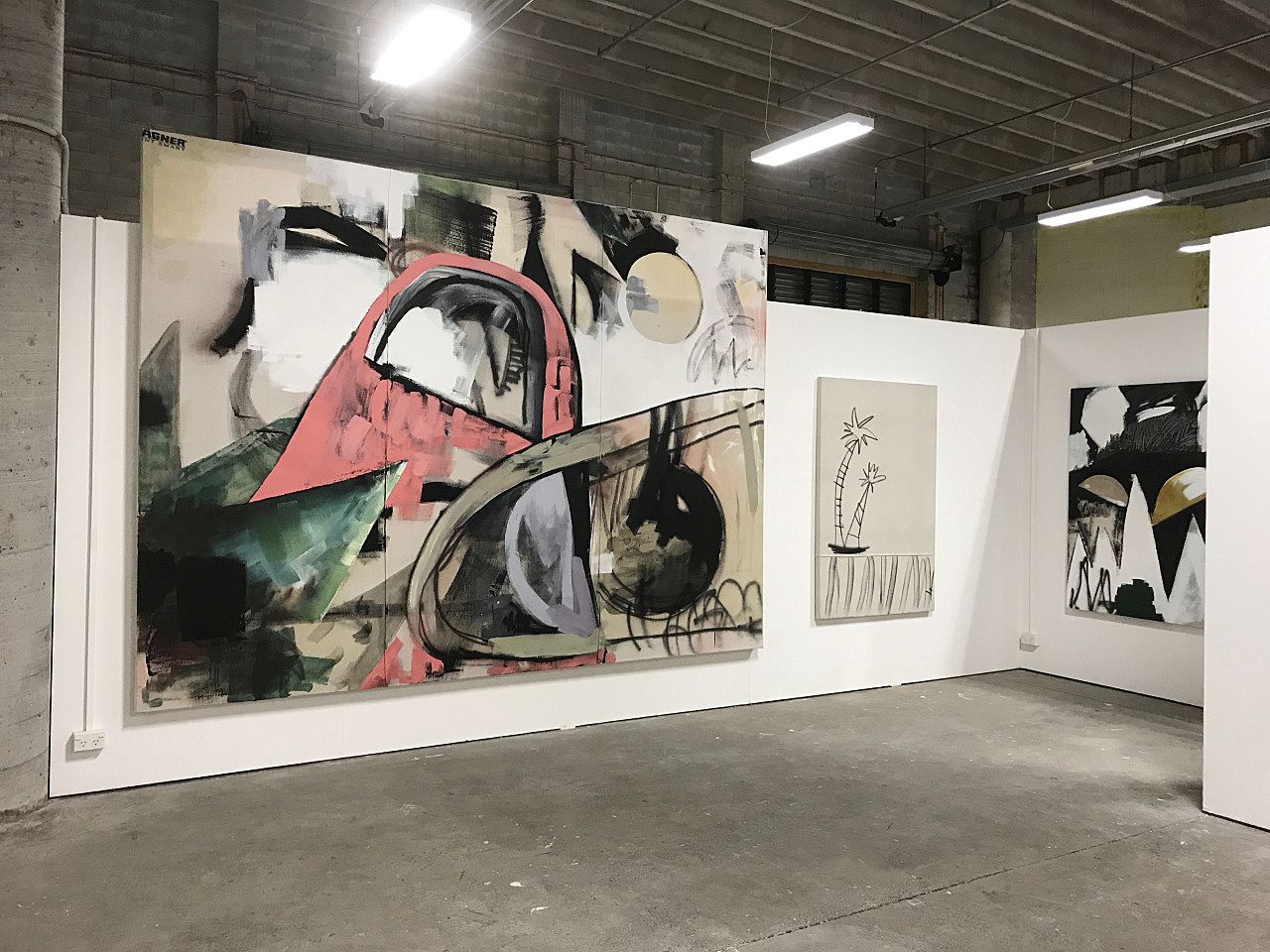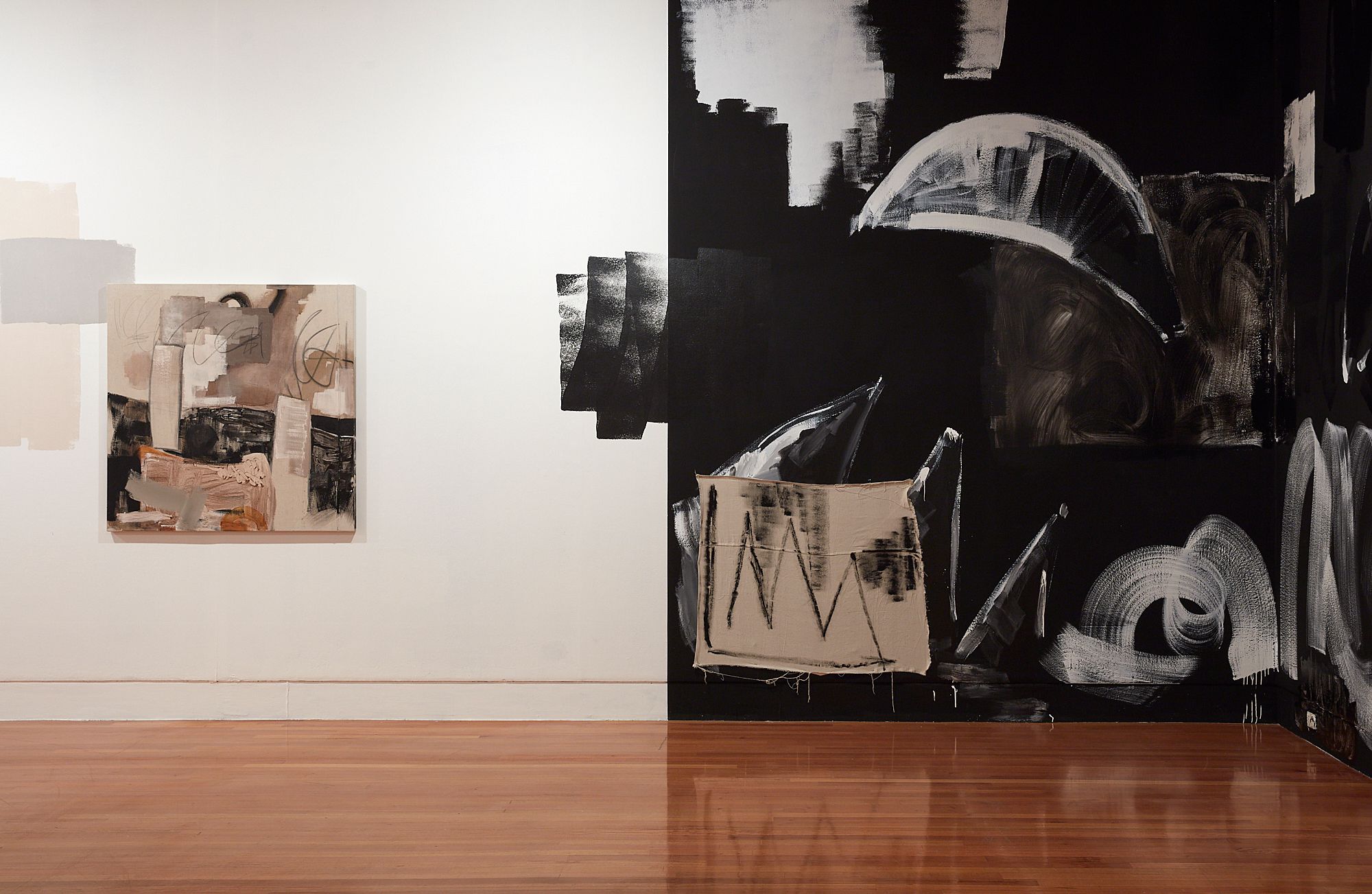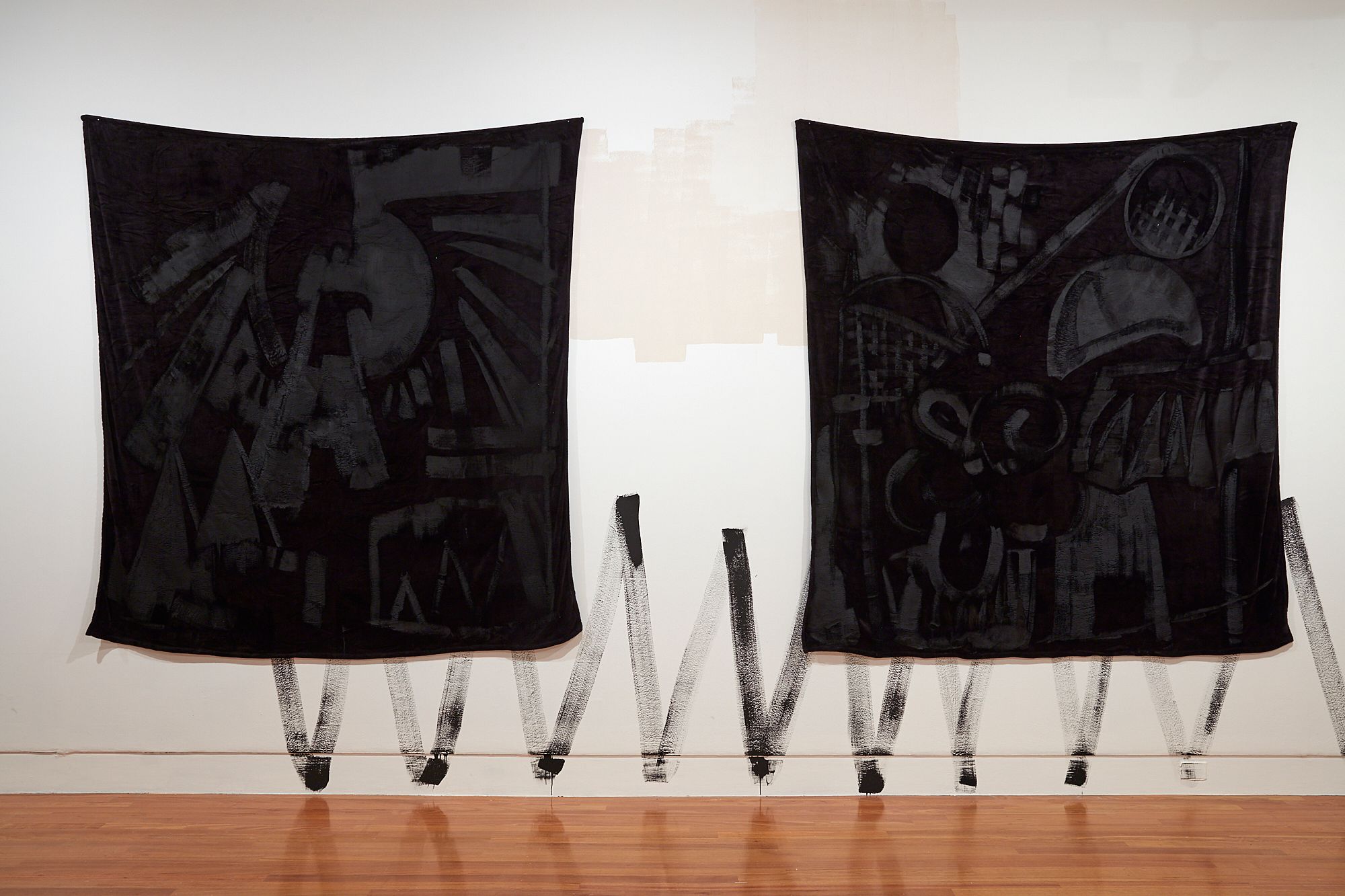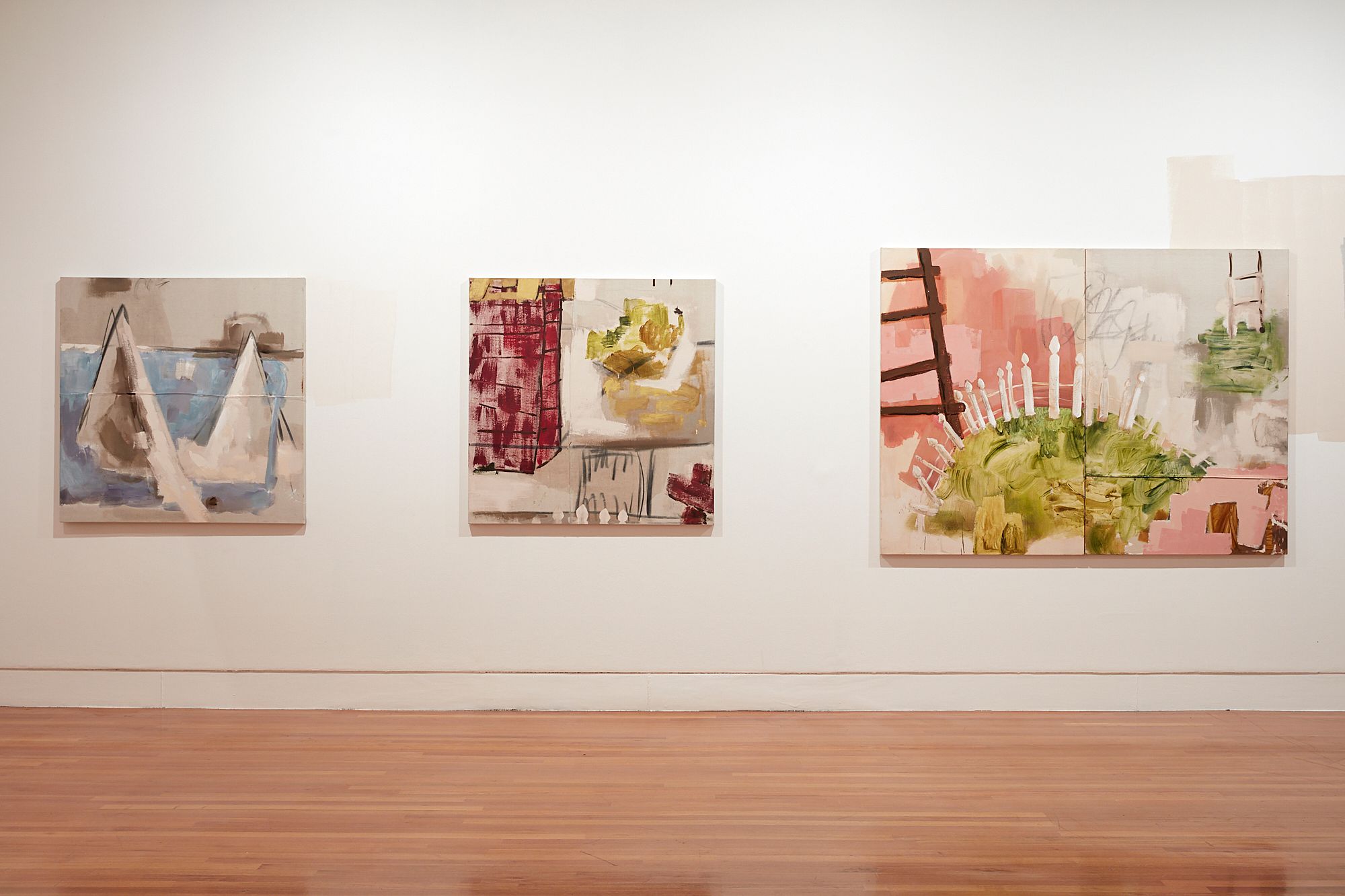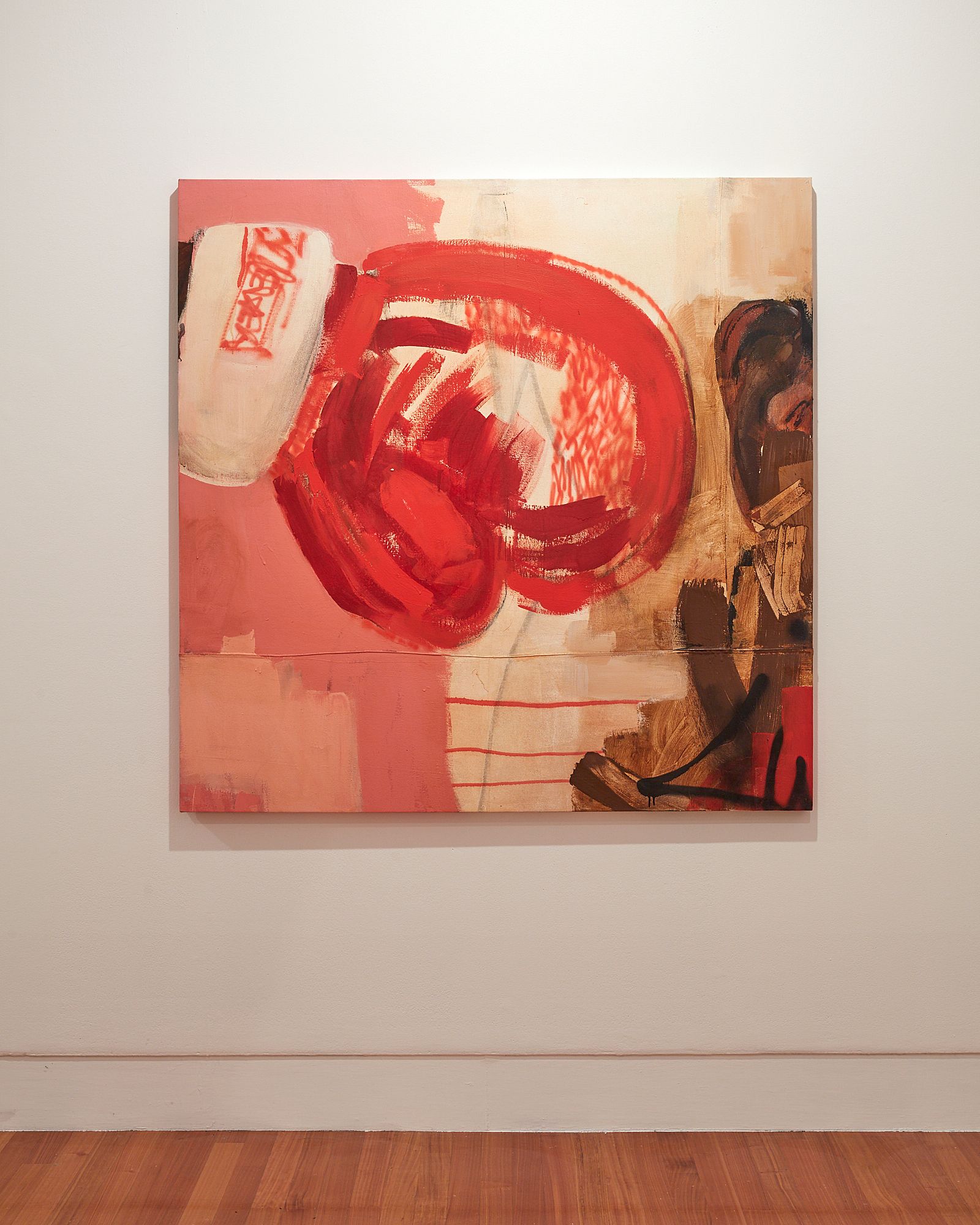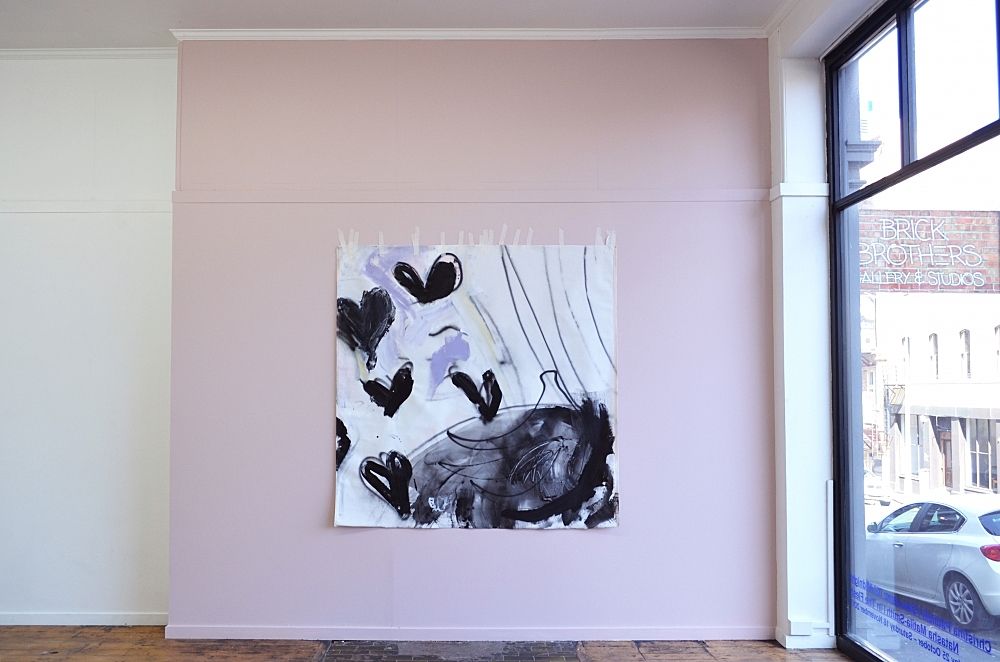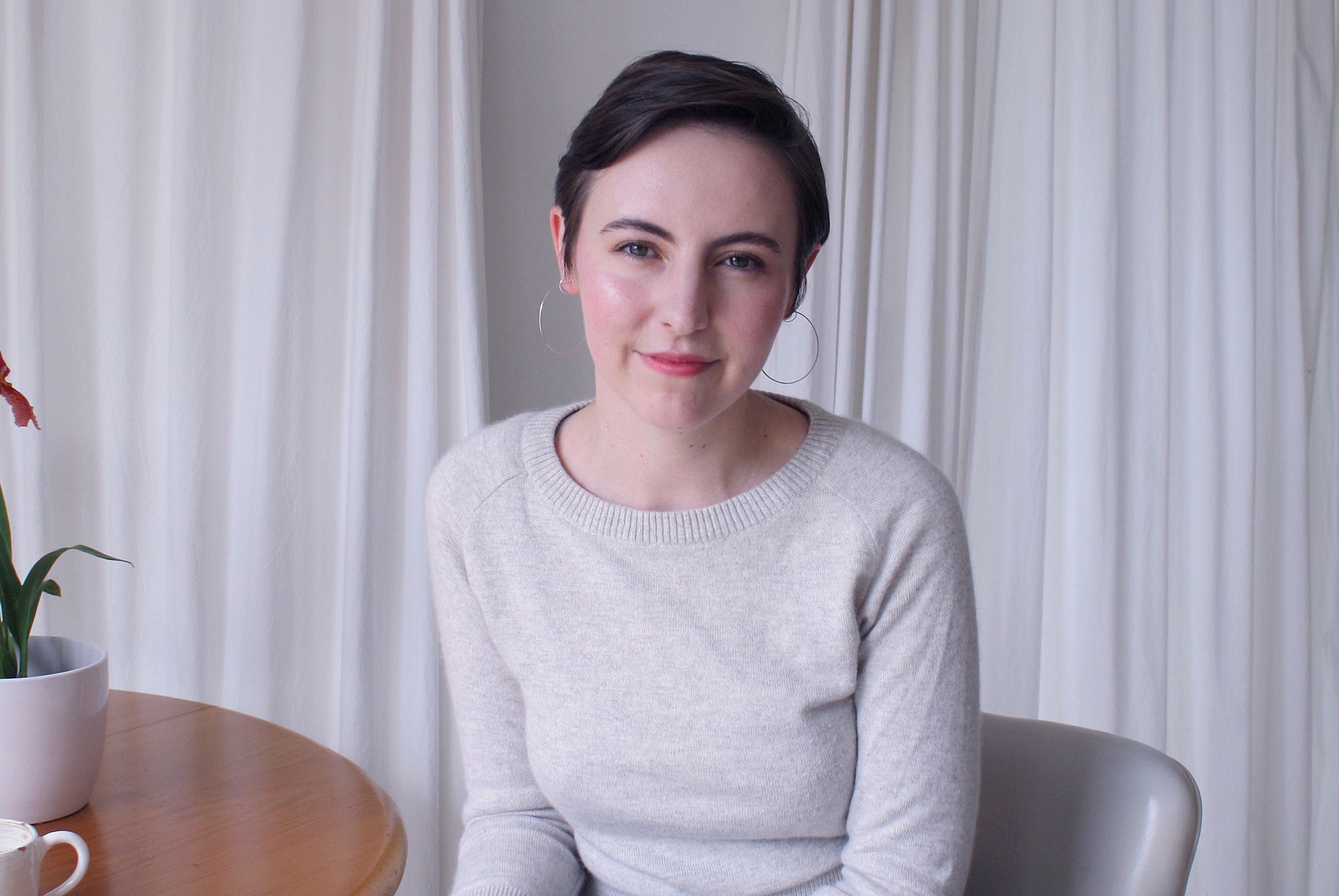A Space Like Belonging: On Christina Pataialii
Can a painting tell you where you are?
Can a painting tell you where you are?
We give things meaning by how we use them, or integrate them into our everyday practices. It is our use of a pile of bricks and mortar which makes it a house; and what we feel, think or say about it that makes a 'house' a 'home.'
Stuart Hall
“I’m into false starts,” Christina Pataialii tells me. “Big, bolshy decisions. Going in without a purpose.”
We are in her newly opened solo exhibition at Te Tuhi, Solid gold, standing before the painting Two minutes to midnight (2018). It’s hard to imagine how one could plan for a painting like this, one that feels so exuberant, so spontaneous, like it could only have happened by happy accident. Sitting somewhere between abstraction and figuration, Two minutes to midnight shows two vast, vivid pink hands, one cradling a cup (each finger a knuckle-less curve, like a row of saveloys) while the other pours. A dribble of brown liquid has just begun to fall. And in the background, something like a blue, flat-topped mountain, something like fog, smears of colour, composed chaos. It’s a painting pushed almost to the brink, so close to rupture that it’s breath-taking, like standing at the edge of a cliff. It makes me think that you can only “go in without a purpose” when you’re really sure of your footing, when you know the terrain like the back of your hand. Pataialii may start a painting without a purpose, but she knows where she’s going – she’s been there before.
Born and raised in various suburbs around Central and West Auckland, Pataialii cites her bicultural Samoan and Pākehā upbringing as the root of much of her creativity. Her paintings draw from the physical and cultural spaces she grew up in, and those she occupies now. They are populated with a motley – often idiosyncratic – array of references sourced from her own life as an artist "raised Samoan, but without the traditional reference points"; a soft sun-bleached palette borrowed from the houses in Mt Albert and Mt Roskill, the spiky black sprigs of rugby boots attached to brown and pink legs, the high crown and swooping brim of a Stetson taken straight from a Spaghetti Western. She had a couple of false starts herself – began a BA at the University of Auckland before her daughter was born, then spent a few years hairdressing before enrolling at Whitecliffe College of Arts and Design and realising that painting was her true home. Or perhaps it was more like a homecoming.
To stand close to them in the boxy exhibition space was to fall into them, to have every painting reduced to whatever part was closest to you at the time...
Pataialii’s confidence with her material derives, at least in part, from a long personal history with paint. The daughter of a house painter, she has been on job sites since she was in utero, and began pitching in as soon as she was old enough to hold a brush. This is almost certainly why she has such faculty with house paint, able to harness its notorious flatness as a way of modulating the dynamism of acrylic, spray paint and charcoal – her other favoured materials. It is also the reason behind her unconventional choice of painting surface. Over the last few years, Pataialii has chosen to work not on canvas but on hand-stretched drop sheets, preferring their heft and weave. Using drop sheets has also allowed her to work at the large scale she prefers, the size of her works dictating a particular relationship between painting, viewer and space.
Take, for example, her 2018 MFA showcase, Slow Jamz Till Midnight – Remix. The paintings there were big, maybe too big. They wrapped around corners, needed extra walls, some were even too large for the walls they clung to. Despite being hung low to the ground, the top of Kingi (2018) still protruded a good ten inches or more above the prefabbed wall. These were paintings that loomed large, took up space, needed more. To stand close to them in the boxy exhibition space was to fall into them, to have every painting reduced to whatever part was closest to you at the time – the jagged leaf of a cabbage tree, a thicket of spray-painted stripes, a flat-rollered patch of putty-coloured paint, a yellow half-moon hanging like a chunk of lemon in a glass of Coke. To stand close to them was to witness how they were made, to mimic the artist’s closeness as she made these marks, to feel the space between her gesture and my gaze. Their immensity within tight confines made them exist in the viewer’s present, paintings as experiences rather than objects pondered from afar.
These mink works operate at multiple levels of familiarity, bringing to mind, first and foremost, the blankets common to homes across Aotearoa; soft, warm and picked up cheaply from the local Warehouse
From her numerous exhibitions – she showed seven times in 2018, with four of these being solo exhibitions – it’s clear that Pataialii is aware of the way her paintings occupy a room, the way we experience them differently up close, or on their own, or hung on a pink wall, or a blue one. With every exhibition, she pushes these considerations further – What if I filled this low-ceilinged gallery with human-scale paintings? What if a prefabbed wall became a giant, site-specific canvas? What if these marks flowed off the canvas, moved onto the walls?
Solid gold at Te Tuhi is something of a culmination of these ideas, a bringing together of the many distinct forms her work takes. There is a giant, dynamic, oily-black wall painting that wraps around a far corner of the gallery, utilising an area of the gallery still painted out from a previous exhibition, reworking that residue. “I wanted it to be like a washing machine, to pull you round the corner and then spit you back out,” Pataialii tells me. There are large paintings hung in grids on the gallery’s high walls, forcing the viewer to crane up at those that are hung high, bringing to mind the neck-ache-inducing salon hangs of traditional galleries across Europe, and throughout history. There are flat patches of neutral-hued paints rollered directly on the walls, as well as dark spray-painted marks like jagged teeth or mountain ranges, paintings hung overlapping them, marks on wall obscured by marks on drop cloth. There are paintings made on black, queen-sized mink blankets, strung from the walls like the pelts of some great inky beasts. These mink works operate at multiple levels of familiarity, bringing to mind, first and foremost, the blankets common to homes across Aotearoa; soft, warm and picked up cheaply from the local Warehouse. They also function as homages to Ralph Hotere, recalling his famous Black Paintings– or as Te Tuhi Artistic Director Gabriela Salgado points out, for the other edge of the Pacific, “the forms…may connect with Chicano velvet paintings.” They connect also to earlier works from Pataialii’s own oeuvre, including gestural paintings made on tiger-printed mink blankets at the beginning of her MFA year, and her subsequent tiger paintings –Rambo, Tyson, Kenya, Sione and Siana, which were themselves inspired by those ubiquitous blankets in addition to the many other tigers she has encountered in her life, primarily through screens – in Kung Fu movies, playing Streetfighter, and in the ostentatious pets kept by pro boxer Mike Tyson in the 1990s. But I digress – the blank mink works we see here are a far cry from her neon tigers. The viewer needs to duck and dive in order to perceive the marks made in black house paint atop the shiny black fabric, yet no matter how much we oscillate before them, the fragments in these paintings do not come together into a figurative whole. In this way they are disorienting, mysterious. They draw us close with their offer of softness and comfort, but their marks quickly dissolve into disarray as we approach, our bodies blocking out the light to obscure our own view.
For those who can pick up the Tāmaki Makaurau radio frequencies, the phrase Solid gold may ring a bell – and that bell may sound like Creedence Clearwater Revival crooning through the airwaves. The title of Pataialii’s show makes reference to the soundtrack of her childhood, the radio station of choice for her dad while cutting in, lugging buckets of paint up ladders, rollering the walls of other people’s homes. Following the theme, many of her recent paintings, including the mink paintings, are titled with lyrics of popular tracks from the likes of The Doobie Brothers, The Beach Boys, Roy Orbison and The Jackson Five – What a fool believes, Good vibrations, Only the lonely, I wanna be where you are (all 2018). As well as referencing “the greatest music of all time,” Pataialii’s paintings also draw on her own personal memories of the job sites on which these tracks became familiar to her; using the familiar forms of fences and ladders as compositional armatures, their presence and function alluding to the way these structures delineate space, providing bodies with access to vertical space, as well as access to private homes in affluent suburbs, the homes of people who can afford to have someone else paint their walls.
If ladders offer ways in and up, fences define who space belongs to. Even a short picket fence with an unlocked gate will act as a deterrent, working to keep people off your lawn, away from what is yours. Pataialii’s use of fence forms across paintings such as What a fool believes and I wanna be where you are (2018) illustrates the complexity of her interest in space, the way this interest spools out into the world to consider national identity, private ownership and the way we deal with space in Aotearoa. Colonial fences encircle empty plots of green, all the while surrounded by the pink patches of graffiti cover-ups. It seems the nostalgia infused in these works goes further than the personal; the hits of the 1960s, 70s and 80s referenced in their titles reminding Pataialii of being on job sites with her dad, but also of the more general connotations of that time in history. This was a period in which the world rapidly shrunk, with the arrival of television and air travel in the 1960s. In a bid to be more in line with the world we could now visualise, America’s Reaganomics was adopted in Aotearoa (as ‘Rogernomics’) for our own free-market revolution, committing us to the economy we live with to this day. It was also a time of increased global mobility, a time in which Aotearoa saw notable levels of Samoan immigration, and the subsequent violent Dawn Raids from the mid-70s to early 80s. With more possibility of movement and a greater focus on individual freedoms than ever, people were seeking their fortunes abroad, only to find these ideals were not spread equally. Fences were everywhere.
They speak to the troubling collective nostalgia that calls for a return to better times, but fails to acknowledge who those times were really better for
Pataialii’s paintings seem to speak to both sides of the coin. They speak to the troubling collective nostalgia that calls for a return to better times, but fails to acknowledge who those times were really better for. But they also acknowledge that our identities are shaped by the soft cultural imperialism of pop music and cartoons, Spaghetti Westerns and warm, cheap blankets from China that drive the ideology, but that also become part of our stories. In their fragmentation, their giddy celebration and uneasy lack of stability, Pataialii’s paintings seem to illustrate the constantly shifting borders of space, identity and culture. They acknowledge the complexity of inheritance.
When we say globalised, so often we really mean Westernised, and when we say Westernised, what we really mean is Americanised. Stetsons, boxing gloves, tigers, white picket fences and the imperial eagle all make regular appearances in Pataialii’s work, as well as cartoonish colours reminiscent of a Simpsons episode, and yucca that could, as Francis McWhannell has pointed out, equally be ferns. In this way, Pataialii’s paintings are deterritorialised, representative of the slippage between what is American and what is of Aotearoa – or even what is Samoan, for that yucca could just as easily be a palm tree. Through abstraction and intense fragmentation, they illustrate that cultural identity, as the late cultural theorist Stuart Hall writes, is "not an essence but a positioning,” the unfirm ground one dances upon in order to live. A rollered patch of colour can be a graffiti cover-up, but it can equally be the first marks of a new colour on the walls of a new home – yours, or that of somebody who’s paying you to colour theirs in. It could also be a clear space, fresh canvas, an opportunity to make new marks.
*
The first time I saw Pataialii’s works in the flesh was at Blue Oyster Project Space in 2017. The exhibition’s titular work, Slow Jamz Till Midnight (2017), was haphazardly attached to a pink wall using painter’s tape. Chubby black hearts rose up out of something like a fruit bowl, floating into lavender space. It reminded me of the way girls at my high school would embellish their school diaries, ignoring the demarcated days of the week, turning each page into a throbbing rainbow heart built of Bic pen and highlighter ink. It made me think how very human the desire to make marks is, to assert your presence in time and space, to protract that presence by leaving a residue. It reminded me of the one time I grafittied something, a phrase daubed in Twink at the edge of a sticky science-room desk. I cringe thinking of it even now, but I’m also struck by the transparency of my own desire: the phrase I painted read my mark.
Pataialii’s paintings deal with this desire at multiple levels. First, there is the artist’s own desire to make marks – a given. Then there is the desire to make marks that mean something, that are your own, that speak to who you are. There is also the desire to situate these marks in space, in a diary, on canvas or drop sheet, hung in a gallery, scrawled on the side of a building, etched into a piece of institutional furniture or cave wall. Finally, the desire to make marks that situate you in history, that refer to your context and are legible to those around you, those who you consider your community. In thinking about these levels, I am reminded again of Hall – specifically, his belief that meaning is not inherent in culture, but produced by how we use things, and how we represent them. The marks Pataialii makes on drop sheets and walls do not hold inherent meaning, but derive meanings from the context they sit within, the other marks they exist alongside, and the way each viewer locates themselves in relation to these.
The eloquence of Pataialii’s work derives, at least in part, from the fact that she uses the medium of paint to consider this desire and its attendant complexities, unpacking the multitude of desires behind each mark even as she succumbs to making them. But it is also the skill with which she handles her medium, using paint to open up space, to pull us in and push us away. Her paintings act physically on a person, calling our positions into question as we struggle to locate the figurative, the background, foreground, the ground we stand upon. Perhaps this is because these paintings stretch back in history, not to rewrite but to remix. Mark-making becomes not a purposeless act, but an intuitive enquiry into where we’ve come from, where we’re going, and where we belong.
Christina Pataialii: Solid gold
Te Tuhi
1 December 2018 – 10 March 2019
This piece is presented as part of a partnership with Te Tuhi. They cover the costs of paying our writers while we retain all editorial control.
